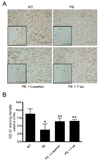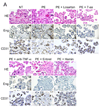Angiotensin receptor agonistic autoantibody-mediated tumor necrosis factor-alpha induction contributes to increased soluble endoglin production in preeclampsia
- PMID: 20065159
- PMCID: PMC2844327
- DOI: 10.1161/CIRCULATIONAHA.109.902890
Angiotensin receptor agonistic autoantibody-mediated tumor necrosis factor-alpha induction contributes to increased soluble endoglin production in preeclampsia
Abstract
Background: Preeclampsia is a prevalent life-threatening hypertensive disorder of pregnancy. The circulating antiangiogenic factor, soluble endoglin (sEng), is elevated in the blood circulation of women with preeclampsia and contributes to disease pathology; however, the underlying mechanisms responsible for its induction in preeclampsia are unknown.
Methods and results: Here, we discovered that a circulating autoantibody, the angiotensin receptor agonistic autoantibody (AT(1)-AA), stimulates sEng production via AT(1) angiotensin receptor activation in pregnant mice but not in nonpregnant mice. We subsequently demonstrated that the placenta is a major source contributing to sEng induction in vivo and that AT(1)-AA-injected pregnant mice display impaired placental angiogenesis. Using drug screening, we identified tumor necrosis factor-alpha as a circulating factor increased in the serum of autoantibody-injected pregnant mice contributing to AT(1)-AA-mediated sEng induction in human umbilical vascular endothelial cells. Subsequently, among all the drugs screened, we found that hemin, an inducer of heme oxygenase, functions as a break to control AT(1)-AA-mediated sEng induction by suppressing tumor necrosis factor-alpha signaling in human umbilical vascular endothelial cells. Finally, we demonstrated that the AT(1)-AA-mediated decreased angiogenesis seen in human placenta villous explants was attenuated by tumor necrosis factor-alpha-neutralizing antibodies, soluble tumor necrosis factor-alpha receptors, and hemin by abolishing both sEng and soluble fms-like tyrosine kinase-1 induction.
Conclusions: Our findings demonstrate that AT(1)-AA-mediated tumor necrosis factor-alpha induction, by overcoming its negative regulator, heme oxygenase-1, is a key underlying mechanism responsible for impaired placental angiogenesis by inducing both sEng and soluble fms-like tyrosine kinase-1 secretion from human villous explants. Our results provide important new targets for diagnosis and therapeutic intervention in the management of preeclampsia.
Figures








Similar articles
-
Angiotensin II type 1 receptor autoantibody (AT1-AA)-mediated pregnancy hypertension.Am J Reprod Immunol. 2013 Apr;69(4):413-8. doi: 10.1111/aji.12072. Epub 2012 Dec 28. Am J Reprod Immunol. 2013. PMID: 23279165 Free PMC article. Review.
-
Autoantibody-mediated angiotensin receptor activation contributes to preeclampsia through tumor necrosis factor-alpha signaling.Hypertension. 2010 May;55(5):1246-53. doi: 10.1161/HYPERTENSIONAHA.110.150540. Epub 2010 Mar 29. Hypertension. 2010. PMID: 20351341 Free PMC article.
-
Angiotensin receptor agonistic autoantibody-mediated soluble fms-like tyrosine kinase-1 induction contributes to impaired adrenal vasculature and decreased aldosterone production in preeclampsia.Hypertension. 2013 Feb;61(2):472-9. doi: 10.1161/HYPERTENSIONAHA.111.00157. Epub 2013 Jan 2. Hypertension. 2013. PMID: 23283357 Free PMC article.
-
Autoantibody-mediated complement C3a receptor activation contributes to the pathogenesis of preeclampsia.Hypertension. 2012 Sep;60(3):712-21. doi: 10.1161/HYPERTENSIONAHA.112.191817. Epub 2012 Aug 6. Hypertension. 2012. PMID: 22868393 Free PMC article.
-
Dysregulation of anti-angiogenic agents (sFlt-1, PLGF, and sEndoglin) in preeclampsia--a step forward but not the definitive answer.J Reprod Immunol. 2009 Nov;82(2):106-11. doi: 10.1016/j.jri.2009.09.001. Epub 2009 Oct 23. J Reprod Immunol. 2009. PMID: 19853925 Review.
Cited by
-
Foxp3+-inducible regulatory T cells suppress endothelial activation and leukocyte recruitment.J Immunol. 2011 Oct 1;187(7):3521-9. doi: 10.4049/jimmunol.1003947. Epub 2011 Aug 26. J Immunol. 2011. PMID: 21873519 Free PMC article.
-
Angiotensin II type 1 receptor autoantibody (AT1-AA)-mediated pregnancy hypertension.Am J Reprod Immunol. 2013 Apr;69(4):413-8. doi: 10.1111/aji.12072. Epub 2012 Dec 28. Am J Reprod Immunol. 2013. PMID: 23279165 Free PMC article. Review.
-
Role of the Uteroplacental Renin-Angiotensin System in Placental Development and Function, and Its Implication in the Preeclampsia Pathogenesis.Biomedicines. 2021 Sep 27;9(10):1332. doi: 10.3390/biomedicines9101332. Biomedicines. 2021. PMID: 34680449 Free PMC article. Review.
-
Four Pathways Involving Innate Immunity in the Pathogenesis of Preeclampsia.Front Cardiovasc Med. 2015 Apr 28;2:20. doi: 10.3389/fcvm.2015.00020. eCollection 2015. Front Cardiovasc Med. 2015. PMID: 26664892 Free PMC article.
-
Autoantibody-mediated IL-6-dependent endothelin-1 elevation underlies pathogenesis in a mouse model of preeclampsia.J Immunol. 2011 May 15;186(10):6024-34. doi: 10.4049/jimmunol.1004026. Epub 2011 Apr 11. J Immunol. 2011. PMID: 21482739 Free PMC article.
References
-
- Roberts JM, Cooper DW. Pathogenesis and genetics of pre-eclampsia. Lancet. 2001;357:53–56. - PubMed
-
- Redman CW, Sargent IL. Latest advances in understanding preeclampsia. Science (New York, N.Y. 2005;308:1592–1594. - PubMed
-
- Dechend R, Homuth V, Wallukat G, Kreuzer J, Park JK, Theuer J, Juepner A, Gulba DC, Mackman N, Haller H, Luft FC. AT(1) receptor agonistic antibodies from preeclamptic patients cause vascular cells to express tissue factor. Circulation. 2000;101:2382–2387. - PubMed
-
- Dechend R, Viedt C, Muller DN, Ugele B, Brandes RP, Wallukat G, Park JK, Janke J, Barta P, Theuer J, Fiebeler A, Homuth V, Dietz R, Haller H, Kreuzer J, Luft FC. AT1 receptor agonistic antibodies from preeclamptic patients stimulate NADPH oxidase. Circulation. 2003;107:1632–1639. - PubMed
-
- Xia Y, Wen HY, Bobst S, Day MC, Kellems RE. Maternal autoantibodies from Preeclampsia patients Activate Angiotensin Receptors on Human Trophoblast Cells. J. Soc. Gyenocologic Investigation. 2003;10:82–93. - PubMed
Publication types
MeSH terms
Substances
Grants and funding
LinkOut - more resources
Full Text Sources
Other Literature Sources
Medical
Research Materials
Miscellaneous

